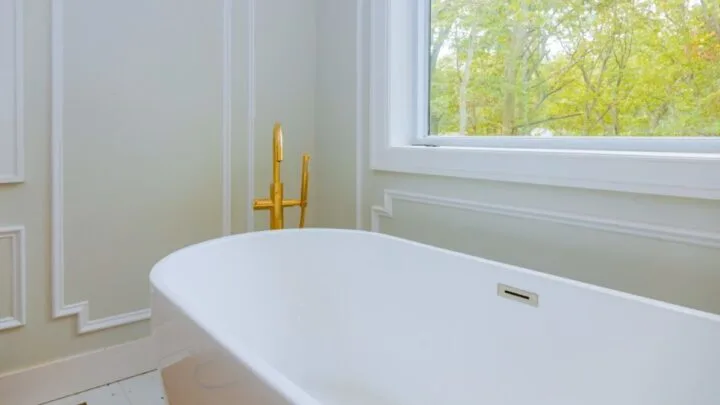Imagine soaking in a warm bath on a cold day, letting the sea salts work their magic to unwind and relax.
When you begin to relax, your plan to soak in the tub for more than an hour goes out the window if the water gets cold before you know it.
So, a heated soaking tub is probably the answer to your prayers. However, a heated soaking tub is much more expensive than a regular one.
It is possible to get a heater for your soaking tub. Heated soaking tubs have a choice between surface heating and water heating. However, they are on the pricier end when compared to a soaking tub without heating mechanics.
First, let us take a look at the types of heated soaking tubs available before going on to the tips to keep water heated in a soaking tub for you to enjoy that much-deserved long luxurious bath on a budget.
Table of Contents
Discover the ultimate relaxation and comfort with these luxurious bathroom fixtures. My guide explores everything you need to know about soaking tubs!
Types of Heated Soaking Tubs
There are generally two types of heated soaking tubs based on their mechanism used for heating.
Warm Surface Soaking Tubs
As evident from the name, warm surface soaking tubs heat up the soak by warming the surface.
The heat panels are integrated into the soaking tub structure. This is similar to the mechanism used to heat the seats of a car.
However, this type of heating mechanism is not as effective as the mechanism that heats up the water itself.
However, it is a feature that adds a luxurious feel to your soaking tub!
Soaking Tubs with Heaters
If you want a warm and luxurious soak, a soaking tub that heats up the water during the time you are in the tub is the best way to enjoy warm water for hours.
This mechanism keeps heating the water in a separate chamber and re-circulates it into the tub.
It uses an in-line heating mechanism that maintains the temperature of the bath with a variance of 1 to 2 degrees.
The in-line mechanism has two suctions, one pulls the water from the bath to heat it, and the other pushes it back into the bath to maintain the temperature.

Other Ways to Keep Water Heated in a Soaking Tub
Apart from the electrical mechanisms to keep the soak warm, there are other ways to keep the water heated in a soaking tub.
1. Soaking Tub Material
When selecting the soaking tub, whether or not it has a heating mechanism installed, it is important to choose a material that is a good insulator so it will retain the heat in the tub for longer.
There are many material varieties available for soaking tubs.
Certain materials encase an insulated material making it better at heat retention, like insulated acrylic tubs.
However, over time its ability to retain heat may decline which means it is time for you to replace your soaking tub or install an external water heater.
Certain materials like cast iron allows for better heat retention as iron absorbs the heat, keeping the soak warmer for a longer time. It also doesn’t have an insulating material within, which means its heating abilities do not deteriorate over time.
2. Preheating Water
One method for retaining the warmth of the water in the soak is heating it more than the desired temperature.
Since the surface of the tub is probably cold, it will absorb the additional heat bringing the water to your desired temperature.
If you don’t preheat, the heat from the water will be absorbed by the tub surface, which will quickly lower the temperature of the water.
3. Quality Bubble Bath
Bubble baths are also a great medium to retain heat in the soak.
The bubble surface acts as a barrier between the water surface and the cold air outside.
If you have preheated your bath for the tub surface to absorb the heat and drawn a bubble bath, you can retain the water’s warmth for longer.
4. Hot Stones
Unless your soaking tub is made of stones that retain heat, like the volcanic basalt stone, you can add additional stones to your soak to retain the water’s temperature.
However, you will have to heat them up before you add them to the bath so they don’t absorb the temperature of the water.
Heating them beforehand will allow them to release the heat during the entirety of your soak.
5. Space Heating
A great way to retain the heat of the water in the soaking tub is getting a space heater.
The space heater will heat up the atmosphere so the water does not lose heat quickly when interacting with the cold air in the bathroom.
You might as well consider placing the bathtub in an enclosed area where the steam can be retained if your bathroom is bigger.
6. Bathtub Heater
Alongside these tips, you can also get a bathtub heater that you can add to your soaking tub if it does not have an in-built heating mechanism.
When choosing the bathtub heater, make sure the capacity of the water heater tank is at least 2/3rds of the water capacity of the soaking tub so it heats the water quickly and evenly.
Summing Up Heated Soaking Tubs
Many soaking tubs come equipped with heating mechanisms. They either heat up the surface of the tub or have an in-line water heating mechanism.
If you have not invested in a heated soaking tub, you can invest in a material that is insulated or one that retains water heat, like stone or iron casted soaking tubs.
Other ways to retain the warmth of the water are using hot stones, adding an external soaking tub heater, and using a space heater to keep the atmosphere warm.
Any method you use to retain the water heat will allow you to enjoy a warm bath that pulls away the day’s stresses.
If you found this article helpful and would like to learn more about soaking tubs, make sure to take a look at the related posts below!


